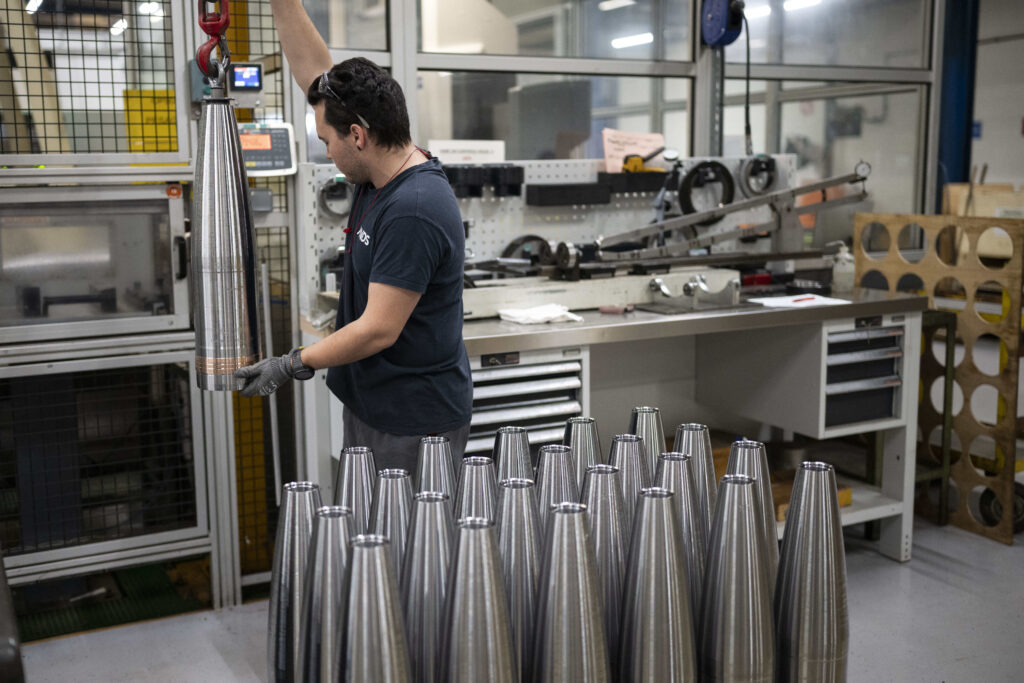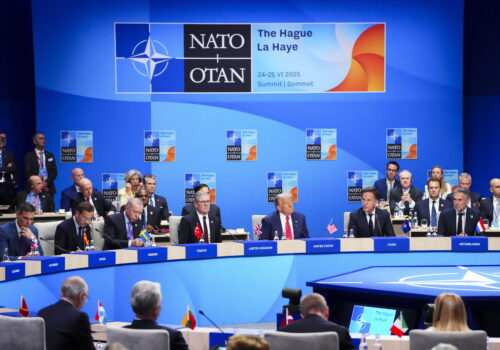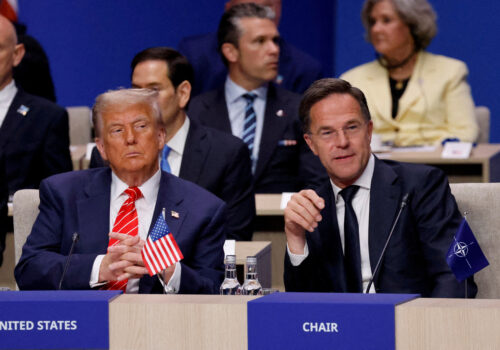At last month’s NATO Summit in The Hague, allies agreed to a new defense spending target: 5 percent of gross domestic product, made up of 3.5 percent for core defense requirements and 1.5 percent for defense enablers. This follows the Alliance approving new capability targets at the Defense Ministerial earlier in June—targets that will allow the Alliance to better resource NATO’s suite of defense plans. Together, these bold steps can breathe new life into NATO’s crucial capability gaps and incentivize allies to invest more in transatlantic innovation efforts. In effect, the Alliance now has both the shopping list and—if states follow through with their spending commitments—the budget to match allied ambition with action.
Yet, the Alliance still faces a crucial disconnect: Without the industrial muscle to increase production and meet rising demand, this positive momentum could grind to a halt.
Industrial capacity is a vulnerability on both sides of the Atlantic. Current allied defense industrial bases are not sized to meet an era of great-power competition. The United States and Europe may face different challenges to their defense industrial landscapes, but the result is the same: As a whole, the Alliance risks losing its war-fighting edge because of its industrial challenges.
A new reality
After the fall of the Soviet Union, the defense industry in the United States consolidated, from more than fifty individual companies to the far fewer “defense primes” of today. In many ways, this consolidation better matched the United States’ strategic outlook immediately after the Cold War. However, even after signals that the world was reentering an era of great-power competition and more intense warfare, Washington did little to rethink these moves.
Only Russia’s full-scale invasion of Ukraine in 2022 laid bare the acuteness of the US defense industrial challenge. The United States found that it could no longer meet Ukraine’s requirements, replenish its newly depleted stock levels, and meet increased demand from allies and partners looking to fill and modernize their own forces. Production lead times began to exceed five years for major munitions. As Washington came to terms with this new reality, it also watched how its military equipment was performing in Ukraine—and it found that conditions on the battlefield were rapidly changing. Russia’s electronic warfare advantages and other tactics threatened to make current equipment obsolete before it was even delivered to the battlefield.
Despite this wake-up call, the US defense industry remains hesitant to adapt to this new reality. Prime contractors added additional shifts to existing production lines, but many have so far been unwilling to invest meaningfully in new plants. Industries tend to be risk-averse, fearing that demand will cool before larger investments can be recouped. This aversion to taking financial risks was further reinforced by concerns that supply chain disruptions and lower levels of workforce availability would make it more difficult to increase production.
A fractured landscape
The other side of the Atlantic faces a different industrial landscape: one that is too fractured. Europe is made up of thirty NATO allies with their own national defense industrial interests that are often unable to produce enough capacity and lack economies of scale. The European Union (EU) is now working to provide funding as a shot in the arm to joint production efforts. But even when European nations and companies agree to cooperate across boundaries, programs tend to get mired in workshare disputes, leading to considerable delays and inefficiencies. This was the case with the A-400M transport and appears to be becoming the case with European sixth-generation fighter programs.
Whether European defense equipment can compete with US systems remains a question—but the promise of US support is invaluable to some allies. Despite, for example, France’s best attempts to institute “buy European” mandates in new EU funding efforts, many NATO allies remain hesitant to remove the United States from the equation.
Breaking down barriers
While the United States and Europe have different industrial landscapes, transatlantic defense industrial cooperation remains an important part of the solution to the issues both sides face. The Hague summit communiqué offered a glimmer of promise in this regard. NATO allies included language on eliminating defense trade barriers, highlighting a shared priority on transatlantic defense industrial cooperation even amid a turbulent period for transatlantic trade.
An important balance is needed. Transatlantic defense industrial bases need to be robust enough to compete with one another, but also resilient enough to cooperate. Fortunately, allies have built much of the groundwork for this. European defense companies already operate facilities in the United States—with companies such as Kongsberg actively expanding their US presence. On the other side of the Atlantic, US counterparts, keen to get a cut of resurgent European defense spending, are exploring opportunities to broaden their already-established presence on the continent.
Since defense industries are risk-averse, allies should consider several additional policy initiatives. To begin with, the United States should increase its use of multiyear procurement. It should also increase the use of its Defense Production Act authority, including by investing in new plants for the most vital munitions, in addition to trying to solve supply chain issues. And Washington should look for more opportunities to use startup companies that are willing to assume risk to rapidly ramp up the production of innovative products.
At the same time, European governments can offset some of the risk that defense companies face by providing investments in defense primes that will in turn allow those companies to invest in expanding the production base for US products overseas. Current examples of this include Javelin production in Poland, NATO Support and Procurement Agency efforts to bring allies together to coproduce Patriot missiles in Germany, and Canberra investing in the production of US munitions in Australia.
Sharpening the war-fighting edge
Importantly, as the United States and Europe expand their industrial bases, they must not sacrifice interoperability. Coproduction and co-development, alongside co-innovation opportunities in research and development, will help keep a focus on this necessary requirement.
To ensure interoperability, the United States should increase exportability investments earlier in the development of defense articles. Washington should also ensure that technology, security, and foreign disclosure processes are transparent and predictable. And where possible, the United States should explore opportunities to coordinate export control processes with its allies, along the lines of the export control terms of the Australia-United Kingdom-United States security partnership known as AUKUS.
For their part, European governments should seek to integrate US defense industry capital, technical expertise, and capacity into their industrial base by ensuring that US industries partnering with local firms and producing in Europe are able to reap economic benefits from increased defense spending.
Neither the United States nor Europe can afford to go it alone in the current geopolitical climate. Instead, transatlantic allies must think more strategically about efforts to share risk, produce jointly, and cooperate on new and innovative capabilities that will sharpen the Alliance’s war-fighting edge.
James A. Hursch is a nonresident senior fellow with the Transatlantic Security Initiative in the Scowcroft Center for Strategy and Security at the Atlantic Council. He previously served as the director of the Defense Security Cooperation Agency and as deputy defense advisor at the US Mission to NATO.
Kristen Taylor is an assistant director with the Transatlantic Security Initiative.
Further reading
Wed, Jun 25, 2025
Experts react: NATO allies agreed to a 5 percent defense spending target in a low-drama summit. Now what?
New Atlanticist By
The Alliance summit was notable for what was said and done, especially about defense spending—but also for what was left off the agenda.
Tue, Jun 24, 2025
Dispatch from The Hague: How Trump can build on his Middle East success with NATO
Inflection Points By Frederick Kempe
As the Alliance summit begins, the US president can already justifiably trumpet three major achievements in the Middle East. Will he add one more in Europe?
Fri, Jun 27, 2025
Four fundamental questions the NATO Summit did not answer
New Atlanticist By Torrey Taussig
Over the coming months, NATO allies will have to wrestle with questions about the US commitment to Europe, their shared approach to China, and more.
Image: This photograph shows 155 millimeter (6.1 in) caliber shells during a visit at the site of the KNDS factory which delivers medium caliber munitions as well as larger caliber shells in La Chapelle-Saint-Ursin, center France on March 21, 2025.Photo by Eliot Blondet / ABACAPRESS.COM via REUTERS




